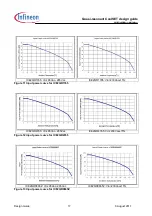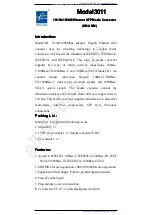
Quasi-resonant CoolSET design guide
ICE2QRxx65/80x
Design Guide
10
8 August 2011
4.3
Normal Operation
The PWM section of the CoolSET can be divided into two main portions: PWM controller for normal operation
and PWM controller for burst mode operation. The PWM controller for normal operation will be described in
the following paragraphs, while the PWM controller for burst mode operation will be discussed in the next
section.
The PWM controller for normal operation consists of digital signal processing circuit including an up/down
counter, a zero-crossing counter (ZC-counter) and a comparator, and analog circuit including a current
measurement unit and a comparator. The switch-on and -off time point is determined by the digital circuit and
the analog circuit, respectively. As input information for the switch-on determination, the zero-crossing input
signal and the value of the up/down counter are needed, while the feedback signal V
FB
and the current
sensing signal V
CS
are necessary for the switch-off determination. Details about the operation of the PWM
controller in normal operation are illustrated in the following paragraphs.
4.3.1
Switch-on Determination
As mentioned above, the digital signal processing circuit consists of an up/down counter, a zero-crossing
counter and a comparator. A ringing suppression time controller is implemented to avoid mistriggering by the
ring after MOSFET is turned off. Functionality of these parts is described as in the following.
4.3.1.1
Up/down Counter
The up/down counter stores the number of zero crossing to be detected to switch on the main power switch
after demagnetisation of the transformer. This value is a function of the feedback voltage, V
FB
which contains
information about the output power. Generally, a high output power results in a high feedback voltage, V
FB
According to this information, the value in the up/down counter is changed to a low value in case of high
feedback voltage, and to a high value in case of low feedback voltage. In ICE2QRxx65/80x, the lowest value
of the counter is 1 and the highest 7. Following text explains how the up/down counter value changes in
response to the feedback voltage
V
FB
. The feedback voltage
V
FB
is internally compared with three thresholds
V
FBZL
,
V
FBZH
and
V
FBR1
. According to the results, the value in the up/down counter is changed, which is
summarised in Table 1 and Figure 6 respectively.
According to the comparison results the up/down counter counts upwards, keeps unchanged or counts
downwards. However, the value in up/down counter is limited between 1 and 7. If the counter tends to count
beyond this range, the attempt is ignored.
In normal case, the up/down counter can only be changed by one each time at the clock period of 48ms.
However, to ensure a fast response to load increase, the counter is set to 1 in the following switching period
after the regulation feedback
V
FB
exceeds the threshold
V
FBR1
.
V
FB
Up/down counter action
Always lower than V
FBZL
Count upwards until 7
Once higher than V
FBZL
, but always
lower than V
FBZH
No changes
Once higher than V
FBZH
, but always
lower than V
FBR1
Count downwards until 1
Once higher than V
FBR1
Counter set to 1
Table 1 Operation of the up/down counter










































